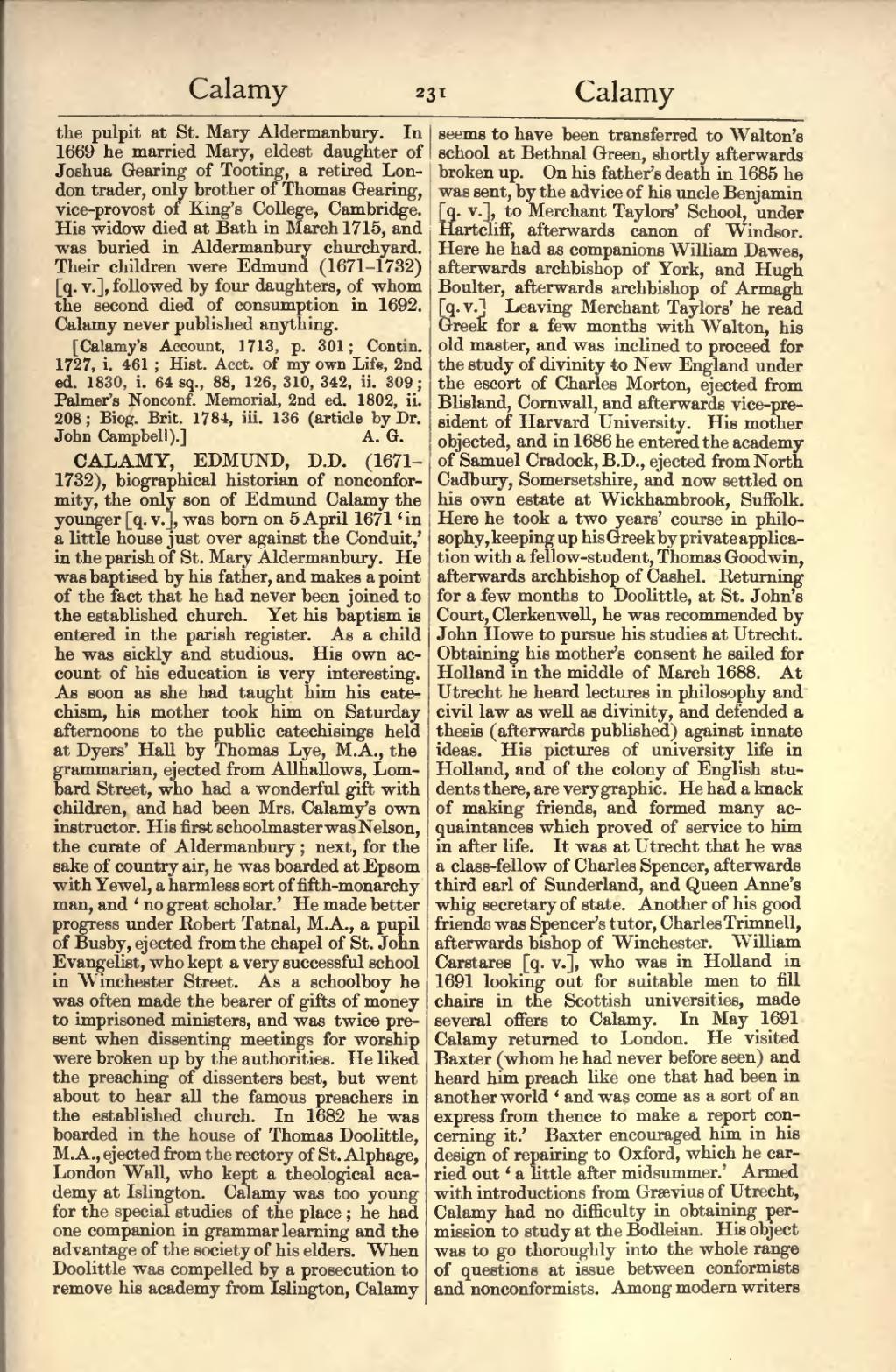the pulpit at St. Mary Aldermanbury. In 1669 he married Mary, eldest daughter of Joshua Gearing of Tooting, a retired London trader, only brother of Thomas Gearing, vice-provost of King's College, Cambridge. His widow died at Bath in March 1715, and was buried in Aldermanbury churchyard. Their children were Edmund (1671–1732) [q. v.], followed by four daughters, of whom the second died of consumption in 1692. Calamy never published anything.
[Calamy's Account, 1713, p. 301; Contin. 1727, i. 461; Hist. Acct. of my own Life, 2nd ed. 1830, i. 64 sq., 88, 126, 310, 342, ii. 309; Palmer's Nonconf. Memorial, 2nd ed. 1802, ii. 208; Biog. Brit. 1784, iii. 136 (article by Dr. John Campbell).]
CALAMY, EDMUND, D.D. (1671–1732), biographical historian of nonconformity, the only son of Edmund Calamy the younger [q. v.], was born on 5 April 1671 ‘in a little house just over against the Conduit,’ in the parish of St. Mary Aldermanbury. He was baptised by his father, and makes a point of the fact that he had never been joined to the established church. Yet his baptism is entered in the parish register. As a child he was sickly and studious. His own account of his education is very interesting. As soon as she had taught him his catechism, his mother took him on Saturday afternoons to the public catechisings held at Dyers' Hall by Thomas Lye, M.A., the grammarian, ejected from Allhallows, Lombard Street, who had a wonderful gift with children, and had been Mrs. Calamy's own instructor. His first schoolmaster was Nelson, the curate of Aldermanbury; next, for the sake of country air, he was boarded at Epsom with Yewel, a harmless sort of fifth-monarchy man, and ‘no great scholar.’ He made better progress under Robert Tatnal, M.A., a pupil of Busby, ejected from the chapel of St. John Evangelist, who kept a very successful school in Winchester Street. As a schoolboy he was often made the bearer of gifts of money to imprisoned ministers, and was twice present when dissenting meetings for worship were broken up by the authorities. He liked the preaching of dissenters best, but went about to hear all the famous preachers in the established church. In 1682 he was boarded in the house of Thomas Doolittle, M.A., ejected from the rectory of St. Alphage, London Wall, who kept a theological academy at Islington. Calamy was too young for the special studies of the place; he had one companion in grammar learning and the advantage of the society of his elders. When Doolittle was compelled by a prosecution to remove his academy from Islington, Calamy seems to have been transferred to Walton's school at Bethnal Green, shortly afterwards broken up. On his father's death in 1685 he was sent, by the advice of his uncle Benjamin [q. v.], to Merchant Taylors' School, under Hartcliff, afterwards canon of Windsor. Here he had as companions William Dawes, afterwards archbishop of York, and Hugh Boulter, afterwards archbishop of Armagh [q. v.] Leaving Merchant Taylors' he read Greek for a few months with Walton, his old master, and was inclined to proceed for the study of divinity to New England under the escort of Charles Morton, ejected from Blisland, Cornwall, and afterwards vice-president of Harvard University. His mother objected, and in 1686 he entered the academy of Samuel Cradock, B.D., ejected from North Cadbury, Somersetshire, and now settled on his own estate at Wickhambrook, Suffolk. Here he took a two years' course in philosophy, keeping up his Greek by private application with a fellow-student, Thomas Goodwin, afterwards archbishop of Cashel. Returning for a few months to Doolittle, at St. John's Court, Clerkenwell, he was recommended by John Howe to pursue his studies at Utrecht. Obtaining his mother's consent he sailed for Holland in the middle of March 1688. At Utrecht he heard lectures in philosophy and civil law as well as divinity, and defended a thesis (afterwards published) against innate ideas. His pictures of university life in Holland, and of the colony of English students there, are very graphic. He had a knack of making friends, and formed many acquaintances which proved of service to him in after life. It was at Utrecht that he was a class-fellow of Charles Spencer, afterwards third earl of Sunderland, and Queen Anne's whig secretary of state. Another of his good friends was Spencer's tutor, Charles Trimnell, afterwards bishop of Winchester. William Carstares [q. v.], who was in Holland in 1691 looking out for suitable men to fill chairs in the Scottish universities, made several offers to Calamy. In May 1691 Calamy returned to London. He visited Baxter (whom he had never before seen) and heard him preach like one that had been in another world ‘and was come as a sort of an express from thence to make a report concerning it.’ Baxter encouraged him in his design of repairing to Oxford, which he carried out ‘a little after midsummer.’ Armed with introductions from Grævius of Utrecht, Calamy had no difficulty in obtaining permission to study at the Bodleian. His object was to go thoroughly into the whole range of questions at issue between conformists and nonconformists. Among modern writers
